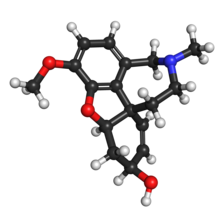
Back غالانتامين Arabic قالانتامین AZB Галантамин Bulgarian Galantamin Welsh Galantamin German Galantamina Spanish گالانتامین Persian Galantamiini Finnish Galantamine French Galantamina Italian
 | |
 | |
| Clinical data | |
|---|---|
| Trade names | Razadyne, Reminyl, others |
| AHFS/Drugs.com | Monograph |
| MedlinePlus | a699058 |
| License data | |
| Pregnancy category |
|
| Routes of administration | By mouth |
| ATC code | |
| Legal status | |
| Legal status | |
| Pharmacokinetic data | |
| Bioavailability | 80–100% |
| Protein binding | 18% |
| Metabolism | Liver partially CYP450:CYP2D6/3A4 substrate |
| Elimination half-life | 7 hours |
| Excretion | Kidney (95%, of which 32% unchanged), fecal (5%) |
| Identifiers | |
| |
| CAS Number | |
| PubChem CID | |
| IUPHAR/BPS | |
| DrugBank | |
| ChemSpider | |
| UNII | |
| KEGG | |
| ChEBI | |
| ChEMBL | |
| PDB ligand | |
| CompTox Dashboard (EPA) | |
| ECHA InfoCard | 100.118.289 |
| Chemical and physical data | |
| Formula | C17H21NO3 |
| Molar mass | 287.359 g·mol−1 |
| 3D model (JSmol) | |
| Melting point | 126.5 °C (259.7 °F) |
| |
| |
| (verify) | |
Galantamine is a type of acetylcholinesterase inhibitor. It is an alkaloid extracted from the bulbs and flowers of Galanthus nivalis (common snowdrop), Galanthus caucasicus (Caucasian snowdrop), Galanthus woronowii (Voronov's snowdrop), and other members of the family Amaryllidaceae, such as Narcissus (daffodil), Leucojum aestivum (snowflake), and Lycoris including Lycoris radiata (red spider lily).[4] It can also be produced synthetically.
Galantamine is primarily known for its potential to slow cognitive decline. It is used clinically for treating early-stage Alzheimer's disease and memory impairments, although it has had limited success with the more advanced condition of dementia.[5][6][7][8]
It works by increasing the amount of a type of neurotransmitter named acetylcholine by the inhibiting activity of enzyme called acetylcholinesterase known for breaking down acetylcholine. This elevates and prolongs acetylcholine levels boosting acetylcholine's neuromodulatory functionality, subsequently enhancing functionality of the various cognitions that acetylcholine is involved in, such as memory processing, reasoning, and thinking.[5] It is a prescription drug taken orally and is also available over the counter.[5][7] Galantamine may cause serious adverse effects, such as stomach bleeding, liver injury or chest pain.[5][7][8]
Galantamine was isolated for the first time from bulbs of Galanthus nivalis (common snowdrop) in the Soviet Union in the 1940s.[9] The active ingredient was extracted, identified, and studied, in particular in relation to acetylcholinesterase (AChE)-inhibiting properties.[10][11] The first industrial process was developed in 1959.[12][13] However, it was not until the 1990s when full-scale synthesis was upscaled and optimized.[14]
- ^ a b "Galantamine Use During Pregnancy". Drugs.com. February 18, 2019. Retrieved February 24, 2020.
- ^ Anvisa (March 31, 2023). "RDC Nº 784 - Listas de Substâncias Entorpecentes, Psicotrópicas, Precursoras e Outras sob Controle Especial" [Collegiate Board Resolution No. 784 - Lists of Narcotic, Psychotropic, Precursor, and Other Substances under Special Control] (in Brazilian Portuguese). Diário Oficial da União (published April 4, 2023). Archived from the original on August 3, 2023. Retrieved August 16, 2023.
- ^ "Active substance: galantamine" (PDF). List of nationally authorised medicinal products, Human Medicines Evaluation Division. European Medicines Agency. November 12, 2020.
- ^ Theodorou M. "Sustainable Production of the Natural Product Galanthamine (Defra), NF0612". NNFCC Project Factsheet. The National Non-Food Crops Centre (NNFCC). Archived from the original on March 14, 2012.
- ^ a b c d "Galantamine". Drugs.com. August 8, 2023. Retrieved March 26, 2024.
- ^ Birks J (January 2006). Birks JS (ed.). "Cholinesterase inhibitors for Alzheimer's disease". The Cochrane Database of Systematic Reviews. 2016 (1): CD005593. doi:10.1002/14651858.CD005593. PMC 9006343. PMID 16437532.
- ^ a b c Cite error: The named reference
kalolawas invoked but never defined (see the help page). - ^ a b Battle CE, Abdul-Rahim AH, Shenkin SD, Hewitt J, Quinn TJ (February 2021). "Cholinesterase inhibitors for vascular dementia and other vascular cognitive impairments: a network meta-analysis". The Cochrane Database of Systematic Reviews. 2021 (2): CD013306. doi:10.1002/14651858.CD013306.pub2. PMC 8407366. PMID 33704781.
- ^ Proskurnina NF, Areshknina LY. J. Chim. Gen. USSR. Chem. Abst. 1947;1948;1742(1595h):1216. No title available.
- ^ Heinrich M (2004). "Snowdrops: The heralds of spring and a modern drug for Alzheimer's disease". Pharmaceutical Journal. 273 (7330): 905–6. OCLC 98892008. Archived from the original on October 23, 2018. Retrieved July 30, 2015.
- ^ Mashkovsky MD, Kruglikova-Lvova RP (1951). "On the pharmacology of the new alkaloid galantamine". Farmakologia Toxicologia. 14: 27–30.
- ^ Heinrich M, Lee Teoh H (June 2004). "Galanthamine from snowdrop--the development of a modern drug against Alzheimer's disease from local Caucasian knowledge". Journal of Ethnopharmacology. 92 (2–3): 147–162. doi:10.1016/j.jep.2004.02.012. PMID 15137996.
- ^ Scott LJ, Goa KL (November 2000). "Galantamine: a review of its use in Alzheimer's disease". Drugs. 60 (5): 1095–1122. doi:10.2165/00003495-200060050-00008. PMID 11129124. S2CID 250305879.
- ^ "Galantamine | ALZFORUM". www.alzforum.org. Retrieved November 17, 2019.
© MMXXIII Rich X Search. We shall prevail. All rights reserved. Rich X Search